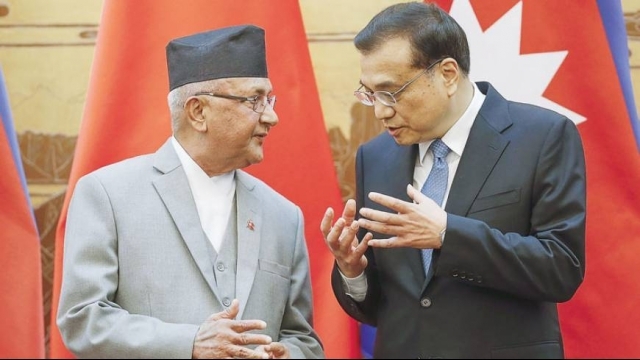Chinese Premier Li Keqiang (R) talks to Nepal Prime Minister Khadga Prasad Sharma Oli at the Great Hall of the People in Beijing.

(Reuters)
China has been eyeing Nepal for some time.
Nepalese Prime Minister KP Sharma Oli returned from a week-long visit to China on March 27. His visit was followed by a visit to Beijing by Nepalese Army Chief General Rajendra Chhetri. Oli had earlier visited India from February 19 to 24. Indo-Nepal relations have been strained since Nepal adopted its new constitution in September 2015. India is sensitive to, traditional friend and predominantly Hindu, Nepal acting against its interests. Madhesi Nepalese of Indian origin feel that the new constitution has failed to address marginalised communities. In Teria, the community protested the delineation of new states, feeling it could affect the political representation of Indian immigrants. This resulted in an unofficial trade blockade. Earlier in 1989-90, India had imposed a 15-month blockade after Nepal bought some Chinese weapons. On March 31, 2016, the joint statement by India and the EU at the Brussels summit made reference to Nepal and expressed hoped for an inclusive constitutional settlement. This irked Nepal. The country, which has had strained relations with China for centuries, now desires to tread a neutral path between its two large neighbours.
In 2004, US consulting firm Booz Allen Hamilton published ‘’ a document that covered China’s investments in a network of naval bases in the Indian Ocean region, stretching from South China Sea to parts of Africa. This became popularly known as the ‘String of Pearls’. Protection of sea lanes for crude oil supplies appeared to be the primary objective. However, India has always looked at this as being encircled by China. China began using geopolitical influence through enhanced diplomatic relations, military supplies, airfield and port construction and economic aid. The Gwadar port on the mouth of Persian Gulf in Pakistan connects Karakoram pass to China through a highway. Financing a shipping centre in Hambantota port in Sri Lanka, a container shipping facility in Chittagong in Bangladesh, a possible base in Marao Atoll in Maldives, a port on the Red Sea in Sudan and a patrolling off the coast of Somalia are all seen as part of China’s ‘string of pearls’. China offered to fund a canal at Kra Isthmus in Thailand which connects the Gulf of Thailand to the Andaman Sea to bypass Malacca Strait. It is an important supplier of military aid to Myanmar and has for long been building roads and airfields there. China developed a deep-water port for them in the Bay of Bengal and an electronic intelligence base at Coco Islands, just 18 kilometres from India’s Andaman Islands. In Sri Lanka,has been making headway. The country sold a plot of land on Galle Road which had been meant for an India Cultural Centre.
To neutralise the Chinese influence, India has been offering funding for monitoring facilities in Madagascar, construction of an airstrip in Mauritania, a radar station in Maldives, Sittwe port in Myanmar and Chabahar port in Iran. Rising China and common security concerns have brought the US, Japan, Australia, ASEAN and India closer for a strategic approach in the region. More recently, India has developed close links with Bangladesh, Myanmar and Sri Lanka to counteract Chinese influence. Emerging democracy in Myanmar will move it closer to India.
ALSO READ India bristles as China woos Nepal
Meanwhile, China has been eyeing Nepal for some time. Nepal continues to struggle with high levels of poverty. Maoists who managed to overthrow the monarchy in 2008 have a significant influence in its national politics today. Historically, the conflicts over territory and control of Tibet have influenced Nepal's relations with China. All that changed with the emergence of a powerful China. The two countries signed a boundary settlement agreement in 1960, and a separate treaty of peace and friendship. They agreed to build an all-weather road connecting Kathmandu to Lhasa in 1961. During the conflict between India and China in 1962, Nepal remained neutral. When the Nepal kingdom was fighting Maoist insurgency, the US and India refused to supply arms to its King. However, China sent arms to the country despite having an affinity with the Maoists. After elections in 2008, the new Maoist-led government wanted to scrap the 1950 treaty with India. It eventually did not. China then began construction of the 770-kilometre railway line from Lhasa to Khasa along the Nepal border.
touched on areas of strategic interests. Accelerating completion of the rail link between two nations, offer by China for Nepal to use Chinese port facilities, building an international airport at Pokhara and the possibility of signing a bilateral free trade agreement. China has suggested setting-up branches of Chinese banks in Nepal.is aimed at strengthening military ties and to seek more training slots for Nepalese Army. No major deals are otherwise on the cards. Since July 2013, China has supplied Rs 821 million of military equipment and two mobile hospitals to the Nepalese Army. China has been providing economic assistance for infrastructure projects. In return,from its Tibetan diaspora.
ALSO READ Nepal wants its independence, sovereignty to be respected: PM Oli
Its commonality with Nepal in religion, language and historic links, gives India an advantage over China. The 1950 Indo-Nepal Treaty of Peace and Friendship ties the two in a special relationship that gives free work access to Nepalese in India and allows Indian and Nepali citizens to travel to each other’s country without visa. Any trade link to China would mean crossing the mighty Himalayas. Access to sea is much closer through the Bay of Bengal. Indian Army maintains seven Gurkha regiments. After China annexed Tibet, Nepal became the buffer state. India also wants a foothold because the porous Nepal border may be used by Islamist terror groups for infiltration. India would have to use maturity in diplomacy with regard to Nepal, balancing the carrot and the stick.